
 |
|
|
Corn
Volume 65 Number 18 Date 11/12/2020 CORN ROOTWORM - Beetle populations increased in 2020 to the highest levels recorded in five years. The annual survey in August documented a state average count of 0.6 beetle per plant in 229 fields, or twice the average found in 2019. The greatest increase was recorded in the south-central district (0.5 beetle to 1.3 beetles per plant), while counts were also relatively high in the southwest and central regions, at 0.6 and 0.7 beetle per plant, respectively. Cornfields with populations above the 0.75 beetle-per-plant economic threshold comprised 27% of this year's sites, compared to last year's 12%. In addition, the 2020 total count of 1,332 beetles was 47% higher than the 711 beetles counted in 2019. Seventy percent of this season's beetles were northern corn rootworm, which has been the predominant species in the state for seven consecutive years. Based on the higher adult corn rootworm populations observed this season, southern Wisconsin corn producers are advised to closely review their rootworm management plans for 2021 and consider crop rotation if practical. Growers opting for a rootworm trait package for root protection are reminded that planting continuous corn with the same trait should be avoided. CORN EARWORM - Pheromone traps captured a cumulative total of 4,747 moths in 18 traps during the late-season monitoring program, with the largest flights recorded during the first week of September. The highest individual pheromone count was 433 moths at Beaver Dam in Dodge County from August 27-September 2. Compared to 2019 when 3,495 moths were collected in 15 pheromone traps, this year's total count was 26% higher. The risk to late sweet corn from migrating corn earworm adults was also elevated in 2020, and the September moth flights produced localized larval damage to apples, corn and tomatoes. Earworm caterpillars were found in 10% of sites surveyed for ECB this fall. EUROPEAN CORN BORER - Larval populations increased from historically low levels in 2018-2019, but remained extremely low. The state average count in 229 cornfields sampled this fall was 0.03 borer per plant, which is only marginally higher than the all-time low average of 0.01 per plant recorded during the two preceding seasons. All three of the state's southern agricultural districts showed averages less than or equal to 2019 levels, while negligible increases were noted in the central and northern areas. Larvae were absent from 90% of the fields sampled in September and October. The near-record low number of corn borers observed again this year reflects the continued prevalence of Bt corn, which accounted for 79% of the state's corn acres in 2020. Another exceptionally small overwintering population indicates the spring moth flight and subsequent first generation of larvae are unlikely to pose a significant early-season threat to the 2021 corn crop. BLACK CUTWORM - Early corn planting and a delayed moth migration resulted in a low risk of spring cutworm damage to emerging corn. Although migrants began appearing in survey traps by April 8, the first significant flights of nine or more moths in two nights did not occur for another month, until May 4. The April 8-June 5 trapping survey captured 1,355 moths in 44 traps, with a peak recorded May 13-19. Significant black cutworm injury was not observed or reported this season. WESTERN BEAN CUTWORM - Moth counts in 2020 were remarkably similar to those recorded in 2019. The annual trapping program from June-August registered an average of 65 moths per trap (3,789 moths in 58 traps), tying 2019 for the second highest average in 16 years. The survey record of 79 moths per trap (10,807 moths total) was set in 2010. The highest individual count for the 10-week monitoring period was 385 moths at Princeton in Green Lake County, the same location that collected the high count of 405 moths in 2019. This season's relatively large flight generated larval injury to scattered cornfields in the west-central and central counties in August and September. -- Krista Hamilton, DATCP Entomologist 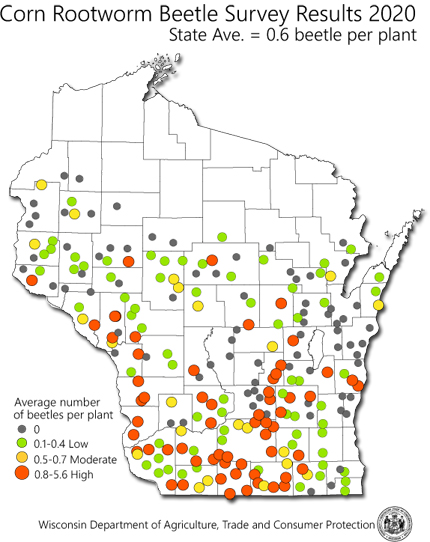

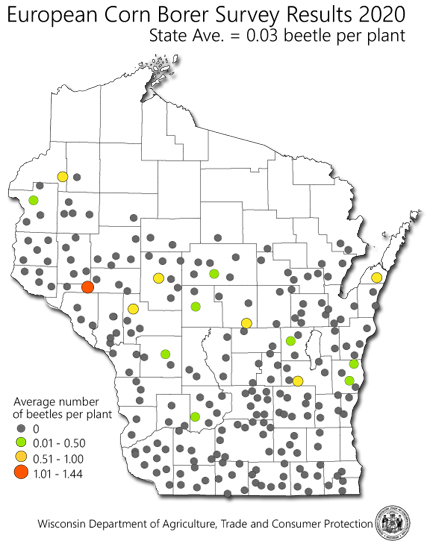
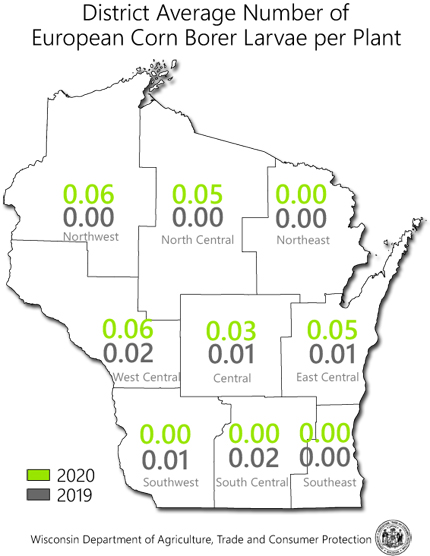
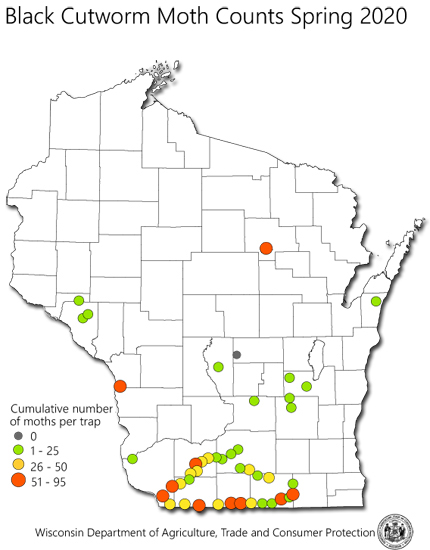
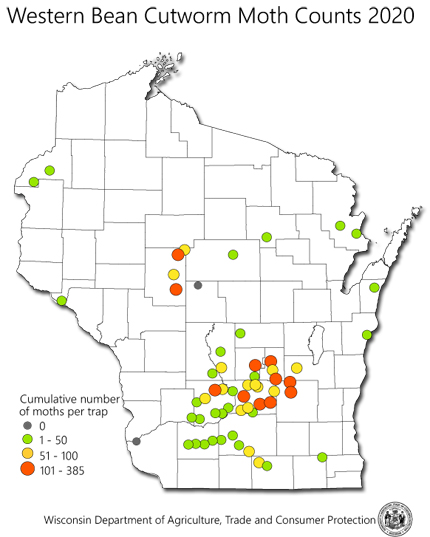
|
|
|